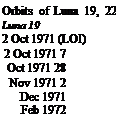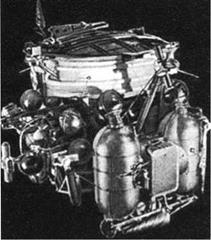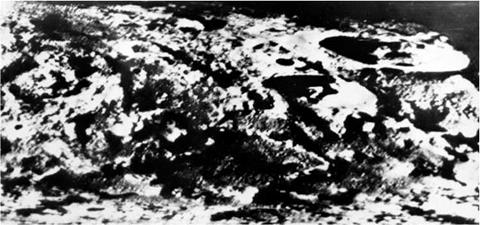MOON ORBITERS
The Ye-8 series included two orbiters, Ye-8LS, both being launched successfully. They flew the last of the trio of rovers of orbiters and rovers, although it had originally been intended they go first. Their role was to:
• Take photographs of points of interest so as to identify landing sites for later sample return, rover and manned missions.
• Study mascons, magnetic fields, the composition of lunar rocks, meteorites and cislunar space.
New cameras were developed for the series by Arnold Selivanov. Essentially, he adapted the optical-mechanical camera of Luna 9 and 13 as an orbital panoramic camera in such a way as to make 180° long panoramic sweeps extending to the edge of the moon. The images would be developed on board, scanned at 4 lines/sec and relayed back to Earth. These are called optical-mechanical linear cameras and can be used from moving spacecraft.
Warning of a new moon probe first appeared in January 1971 when predictions of ‘low-flying artificial satellites’ were made that would fly ‘fairly soon’. Sure enough, Luna 19 was launched on 28th September 1971 and entered circular lunar orbit of 140 km at 40°, 2 hr 01 min, on 3rd October. Two sets of details were published for the
|
Ye-8LS |
first day of operation, indicating either a tweaking of the orbit or a refinement of the earlier figures. Three days later, it settled into steady operational orbit of 127 x 135km, 2hr 01 min, 40°. It is more than likely that Luna 19 kept the large tanks used for orbital insertion and continued to use them for manoeuvres, rather than drop them soon after arrival in lunar orbit. The mission was publicized through periodic reports in Pravda and Izvestia. Although at least five full panoramas were assembled, only one section of one was published, along with an illustration showing the probe being loaded onto its Proton carrier rocket, but the detail is poor.
The mission lasted till 3rd October 1972 and 1,000 communication sessions were held. Luna 19 reported back on magnetic fields, mascons, the lunar gravity field, meteoroids and sent back televised pictures of an area 30°S to 60°S and 20°E to 30°E, the quality of publication much improved compared with Luna 12 in 1966. In February 1972, it swept over the Torrid Gulf near the crater Eratosthenes (11°W, 15°N) and filmed rock-strewn plains above which reared a volcanic-like summit. In order to take such pictures it had dropped into a new, lower orbit of 77 x 385 km, 131 min. Another landing area surveyed was around craters Godin and Agrippa at 10°E, 3°N. Some science reports were issued, noting how Luna 19 had measured solar flares and plasma, mascons, the lunar surface and the composition of its soil. The strength of the magnetic field on the nearside and farside of the moon was compared. Radiation levels were measured, especially their rise and fall during solar flares. Ten solar flares were detected. Some cislunar plasma was detected, but the outcome of this experiment was unclear. An altimeter called Vega was carried to measure the precise distance of the probe to the moon (important during its low perilunes). A gamma ray spectrometer took broad measurements of the composition of the lunar surface. A radio occultation experiment was carried out in May 1972 and this found charged particles about 10 km over the moon. The magnetometer measured magnetic fields as the moon moved in and out of the Earth’s long magnetic tail. The mission lasted 4,000 orbits.
|
Luna 19 low pass |
It was a full year before the next orbiting moon probe, Luna 22, took off on 2nd June 1974. The Luna 22 launch came at an important international moment, for the first Soviet-American conference on lunar exploration took place that month, June 1974. Together, the scientists were able to agree on the approximate date of the moon (4bn years), the nature of its crust (thick), the processes that had shaped it and that the moon shared a broadly similar formation to the Earth.
Ground observatories tracked Luna 22 as far as 250,000 km out. Luna 22 entered almost circular moon orbit at 219 x 221km, 2 hr 10 min, 19.6° four days later. A week later, it swooped down to 25 x 244 km for special photography for four days, before going back up again to 181 x 299 km. Over the next year, Luna 22 several times altered its orbit, displaying both versatility and reliability. In November 1974, coinciding with the arrival in orbit of Luna 23, it operated in an eccentric orbit of 171 x 1,437km out, 3 hr 12 min, then raising its perilune to 200 km and making a minor plane change to 21°. Then, in August 1975 it dipped to a mere 30 km over the surface for a week, going out farther to 1,578 km, before returning to a regular orbit of 96 x 1,286 km out when its mission ended in November 1975.
Lunar orbit photography was done both from altitude and at low points, the latter presumably to search for landing sites, but no details were ever given of the sites surveyed and the following two Lunas (23 and 24) were both aimed at the Luna 15 sites which, presumably, had been mapped before 1969. There were two extended periods in which no manoeuvres were made, presumably so as to give time to measure changes to its path arising from distortions in the moon’s gravitational field.
Few scientific results were released from the mission, although they could have been substantial, as evidenced by the heavy radio traffic to and from the probe over the 18 months of its operation. These results could have covered the surface composition, topography and micometeoroid impacts, which were much fewer in the higher orbit. Lunar topography was mapped carefully through the use of an altimeter and a gamma ray spectrometer analyzed the composition of the surface [12]. Science reports indicated that Luna 22 studied the moon’s gravitational field, micrometeorites (23 impacts recorded) and solar plasma. The probe indicated that a sheath of ionized gas forms 8 km over the lunar surface during sunlight. Eight photographs eventually reached the NASA archives in the 1990s. Ten full panoramas were reportedly assembled.
 140 x 148 km, 2hr 04min, 40.58°
140 x 148 km, 2hr 04min, 40.58°
140 km circular, 2 hr 01 min, 40.58°
127 x 135km
77 x 385km, 2hr 11 min
127 x 135 km
77 x 385km, 2hr 11 min
219 x 221km, 2 hr 10 min, 19°
 25 x 244km for four days 181 x 299 km
25 x 244km for four days 181 x 299 km
171 x 1,437km, 3hr 12min, 19.55°
200 x 1,409 km, 3hr 12 min, plane change to 21° 30 x 1,578 km
Orbit raised to 96 x 1,286 km, 21°
The orbital paths of the two missions show similarities and differences. Having adjusted its original insertion orbit, Luna 19 operated for the first portion of its mission from a 127 x 135-km near-circular orbit (October-November). At the end of November, it dropped its perilune to 77 km for three days of photographic observations, before coming back to the circular orbit. In February, Luna 19 went back to its lower perilune, where it apparently stayed. Luna 22, by contrast, followed three sets of orbits. Its operating orbit was around 200 km, dropping twice for photographic surveys for periods of less than a week, in late June 1974 and late August 1975. The perilunes were on both occasions much lower than those of Luna 19, this time descending to 25-30 km. In addition, Luna 22 also flew, twice, into an eccentric orbit, out as far as 1,578 km. The precise rationale for these manoeuvres has never been explained.












